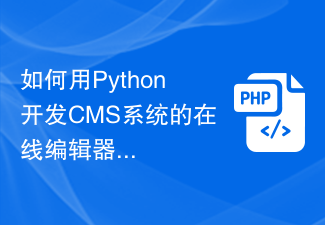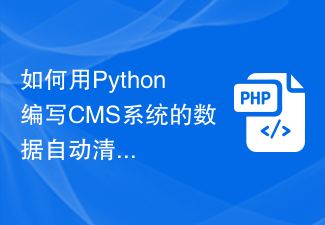 Java
Java javaTutorial
javaTutorial How to use Java to write an automatic platform optimization module for a CMS system
How to use Java to write an automatic platform optimization module for a CMS systemHow to use Java to write an automatic platform optimization module for a CMS system
Abstract: With the rapid development of the Internet, content management systems (CMS) play a vital role in website and application development. But what follows is a rapid increase in data volume and an increase in platform complexity. In order to improve the performance and stability of the CMS system, the automatic platform optimization module has become an essential component. This article will introduce how to use Java to write the automatic platform optimization module of the CMS system and give corresponding code examples.
- Introduction
A content management system (CMS) is a software tool used to create, publish and manage website content. It enables webmasters to add, edit and publish content through a simple user interface, while managing the design and structure of the website. However, as the size of the website continues to expand, it becomes increasingly difficult to manage and maintain the CMS system. - The role of the automatic platform optimization module
The automatic platform optimization module is a component that can automatically analyze CMS system performance bottlenecks and automatically adjust system parameters to improve performance and stability. It can dynamically adjust system resources based on indicators such as website visits, number of database connections, CPU and memory usage. At the same time, it can also automatically detect and repair some common problems, such as database connection pool leaks, memory leaks, etc. - Use Java to write the automatic platform optimization module of the CMS system
The following are some sample codes for using Java to write the automatic platform optimization module of the CMS system:
import java.util.Timer;
import java.util.TimerTask;
public class AutoPlatformOptimizer {
private static final long OPTIMIZE_PERIOD = 24 * 60 * 60 * 1000; // 优化周期为一天
public void start() {
Timer timer = new Timer();
timer.schedule(new TimerTask() {
@Override
public void run() {
optimize();
}
}, 0, OPTIMIZE_PERIOD);
}
private void optimize() {
// 在这里编写自动优化的逻辑
// 分析系统性能指标
// 根据性能指标调整系统资源
// 检测和修复常见问题
}
}
public class CMSApp {
public static void main(String[] args) {
AutoPlatformOptimizer optimizer = new AutoPlatformOptimizer();
optimizer.start();
}
}In the above example In the code, the AutoPlatformOptimizer class is the main class of the automatic platform optimization module, and the start() method is used to start the automatic optimization task. The Timer and TimerTask classes are used to execute optimization tasks regularly. The OPTIMIZE_PERIOD constant defines the optimization period, which is set to one day here.
In the optimize() method, we can write specific automatic optimization logic, such as dynamically adjusting system resources based on performance indicators, detecting and repairing common problems, etc. Specific optimization strategies and algorithms can be determined based on actual needs.
- Summary
The automatic platform optimization module plays an important role in improving the performance and stability of the CMS system. Using Java to write the automatic platform optimization module of the CMS system can easily monitor and optimize system performance. Through scheduled tasks and corresponding optimization strategies, we can improve the efficiency and reliability of the CMS system.
However, it should be noted that the automatic platform optimization module is only a means to improve the performance of the CMS system. Other factors also need to be considered comprehensively, such as rationally designing the database model, optimizing the front-end page, etc. Only by comprehensive consideration and all-round optimization can the CMS system achieve better performance and user experience.
References:
- Java official documentation: https://docs.oracle.com/javase/8/docs/api/
- CMS System Optimization Guide :https://www.smashingmagazine.com/2019/09/website-performance-optimization-cms/
- Java Programming Thoughts (4th Edition)
The above is the detailed content of How to use Java to write an automatic platform optimization module for a CMS system. For more information, please follow other related articles on the PHP Chinese website!
 cms系统哪个好?十大开源CMS建站系统【总结推荐】Jul 27, 2022 pm 04:01 PM
cms系统哪个好?十大开源CMS建站系统【总结推荐】Jul 27, 2022 pm 04:01 PM互联网的蓬勃发展,免费且开源的建站系统的层出不穷,而我们经常在网上看见有人问及”哪个CMS系统最好用”、”企业建站用哪个CMS系统最多”等类似问题。下面PHP中文网就来给大家总结分享十大开源CMS建站系统,排名不分先后,一起来看看吧!
 帝国cms管理员在哪个表Feb 22, 2023 pm 07:00 PM
帝国cms管理员在哪个表Feb 22, 2023 pm 07:00 PM管理员表有:1、phome_enewsuser,是管理员记录表;2、phome_enewsdolog,是管理员操作记录表;3、phome_enewsgroup,是管理员用户组数据记录表;4、phome_enewslog,是管理员登陆日志;5、phome_enewsloginfail,是管理员登陆失败记录表;6、phome_enewserrorclass,是管理员错误报告记录表。
 如何用Python开发CMS系统的在线编辑器功能Aug 04, 2023 am 09:45 AM
如何用Python开发CMS系统的在线编辑器功能Aug 04, 2023 am 09:45 AM如何用Python开发CMS系统的在线编辑器功能随着互联网的发展,CMS系统成为了许多网站开发者的首选。作为一种内容管理系统,它可以帮助用户轻松创建、编辑和发布网站内容。而在线编辑器功能是CMS系统中一个必不可少的组件,它允许用户在网站上直接编辑并保存内容。本文将介绍如何使用Python开发CMS系统的在线编辑器功能,并提供一些代码示例。在开始之前,我们需要
 帝国cms可以删除模块吗Mar 13, 2023 pm 07:18 PM
帝国cms可以删除模块吗Mar 13, 2023 pm 07:18 PM帝国cms可以删除模块。删除模块的方法:1、登录帝国CMS后台,依次点击“系统”-“系统设置”-“系统参数设置”-“关闭相关功能”,根据自己网站的需求,自行勾选设置来关闭对应的模块功能;2、关闭功能后,删除对应模块的在e目录下的子目录;3、修改e目录下的php文件,在文件第二行加上代码“exit();<?php exit()”,并保存修改即可。
 PHP中的CMS系统开发指南May 21, 2023 pm 02:51 PM
PHP中的CMS系统开发指南May 21, 2023 pm 02:51 PM随着互联网的发展,网站已经成为人们获取信息和交流的重要方式。而为了更好地管理和维护网站内容,CMS(ContentManagementSystem)系统应运而生。作为一种常用的建站工具,CMS系统提供了一种简单、快捷、高效的方式来建立和管理网站。而PHP作为一种强大的后端语言,在CMS系统开发中应用广泛。本文将为大家讲解PHP中的CM
 PHP开发CMS系统完成后如何进行有效的测试Jun 21, 2023 am 10:58 AM
PHP开发CMS系统完成后如何进行有效的测试Jun 21, 2023 am 10:58 AM在日益发展的互联网时代中,CMS系统已经成为了网络建设中的一项重要工具。其中PHP语言开发的CMS系统因其简单易用,自由度高,成为了经典的CMS系统之一。然而,PHP开发CMS系统过程中的测试工作也是至关重要的。只有经过完善、系统的测试工作,我们才可以保证开发出的CMS系统在使用中更加稳定、可靠。那么,如何进行有效的PHP开发CMS系统测试呢?一、测试流程的
 如何用Python编写CMS系统的数据自动清理功能Aug 04, 2023 am 08:13 AM
如何用Python编写CMS系统的数据自动清理功能Aug 04, 2023 am 08:13 AM如何用Python编写CMS系统的数据自动清理功能在现代的CMS(ContentManagementSystem)系统中,数据的积累是不可避免的。随着时间的推移,庞大的数据量可能会导致系统性能下降,并且无用数据的堆积可能会占用服务器的存储空间。因此,为了确保系统的高效运行,我们需要一个数据自动清理功能来定期清理无用数据。Python是一种强大的编程语
 如何用Python搭建CMS系统的主题管理功能Aug 04, 2023 am 10:09 AM
如何用Python搭建CMS系统的主题管理功能Aug 04, 2023 am 10:09 AM如何用Python搭建CMS系统的主题管理功能CMS(内容管理系统)是一种用于管理和发布内容的软件程序。它可以帮助用户创建、编辑和组织各种类型的内容,例如文章、图像和视频等。在一个大型的CMS系统中,主题管理功能十分重要,因为它可以让用户轻松地改变网站的外观和风格,从而满足不同的需求和目标。本文将介绍如何使用Python搭建CMS系统的主题管理功能。我们将使


Hot AI Tools

Undresser.AI Undress
AI-powered app for creating realistic nude photos

AI Clothes Remover
Online AI tool for removing clothes from photos.

Undress AI Tool
Undress images for free

Clothoff.io
AI clothes remover

AI Hentai Generator
Generate AI Hentai for free.

Hot Article

Hot Tools

SublimeText3 Mac version
God-level code editing software (SublimeText3)

SublimeText3 Linux new version
SublimeText3 Linux latest version

SecLists
SecLists is the ultimate security tester's companion. It is a collection of various types of lists that are frequently used during security assessments, all in one place. SecLists helps make security testing more efficient and productive by conveniently providing all the lists a security tester might need. List types include usernames, passwords, URLs, fuzzing payloads, sensitive data patterns, web shells, and more. The tester can simply pull this repository onto a new test machine and he will have access to every type of list he needs.

WebStorm Mac version
Useful JavaScript development tools

SublimeText3 English version
Recommended: Win version, supports code prompts!





